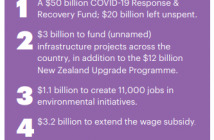Amongst the sectors, roles in property and engineering suffered dips in average pay rates down 5.4 and 5 percent respectively, while trades and services jumped 6.2 percent.
Also, demand for construction workers in Auckland has exceeded the number of qualified applicants, reminiscent of Christchurch over the past few years, meaning jobs are going unfilled.
The number of job vacancies advertised on Trade Me Jobs grew over the last quarter as did the number of applications, continuing a trend observed at the end of 2015.
Analysis of the 57,000 jobs advertised throughout the last three months shows that total listings were up 4.1 percent on the same period last year, and the average number of applications per listing rose by 8.7 percent.
Head of Trade Me Jobs Peter Osborne said this meant there was increased competition for jobs and ongoing momentum in favour of employers. “There are some great signs of growth in listings but the number of people applying tell the story that job hunters will be finding things more difficult.”
Osborne said longer term “structural shifts” in the employment market were providing challenges for both employers and job hunters. “The types of roles on offer aren’t always a good match for the people available to fill them. If there aren’t enough qualified or suitable candidates, the role goes unfilled or a hire is made and there’s a higher chance of it being a poor fit, which often leads to dissatisfaction and underperformance.”
He cited construction and sales as obvious examples. “Demand for construction workers in Auckland has exceeded the number of qualified applicants, reminiscent of Christchurch over the past few years, meaning jobs are going unfilled.
“And on the other side of the coin there are more people looking for work in sales but a decline in jobs available, meaning it’s been far more difficult for salespeople to land a job. The problem is people aren’t always willing or able to pack up and head to Auckland for work, and they might not have the skills to be able to do the work.”
Osborne said that these shifts tend to wax and wane over time and that jobs on offer and worker skills were never perfectly matched. “Of course, while it’s good to know these things change constantly, it doesn’t help pay the bills if you’re looking for work and having difficulty right now.
“The message for employers and job hunters is to keep an eye on trends in your industry, and plan ahead so a skill shortage doesn’t bite you. That includes upskilling on the job, training and development, and of course being willing to think laterally and applying skills to different types of jobs. For job hunters the flexibility to move to where the work is will be a massive help too.”
Salary slide
The average salary for roles listed on Trade Me dipped this quarter, down 1.9 percent to $60,442. The wider Wellington region was the biggest loser, with a drop of 5.2 percent year-on-year, down to $66,571. However, Wellington continues to hold the top spot for average rate of pay at $72,490, more than $2000 higher than Auckland.
Amongst the sectors, roles in property and engineering suffered dips in average pay rates down 5.4 and 5 percent respectively, while trades and services jumped 6.2 percent.
IT roles continue to dominate the top five highest average pay rate slots, with IT consultants at number one with an average pay rate of $148,190.
Regional round-up
Around the regions it was generally positive news in terms of listing growth with eleven regions showing an increase in listings on this time last year and only four declining.
The star performers of the last quarter were Hawke’s Bay (up 17.6 percent) and Bay of Plenty (up 16.3 percent). For the second quarter in a row, Hawke’s Bay, Nelson/Tasman and Otago all experienced double-digit growth.
Canterbury and the West Coast saw significant reductions in listings again this quarter, down 9.7 and 6.3 percent respectively.
In the sectors
IT continues to dominate the average pay statistics, but along with banking, finance and insurance it saw a significant double-digit decline in listings.
There was better news for candidates looking for architecture and education roles, with both seeing significant increases in listings of 36.7 percent and 23.4 percent respectively. Osborne said trades and services saw “fantastic growth” too, up 15.3 percent.
Listings’ growth: Quarter one 2016 versus quarter one 2015
| Category | Year-on-year % change |
| Accounting | – 8.2 |
| Agriculture, fishing & forestry | 4.8 |
| Architecture | 36.7 |
| Automotive | 4.8 |
| Banking, finance & insurance | – 18.3 |
| Construction & roading | 17.5 |
| Customer service | 8.2 |
| Education | 23.4 |
| Engineering | – 5.8 |
| Executive & general management | 6.9 |
| Government & council | 2.0 |
| Healthcare | 1.1 |
| Hospitality & tourism | 11.6 |
| HR & recruitment | 13.6 |
| IT | – 24.8 |
| Legal | 7.7 |
| Manufacturing & operations | 1.7 |
| Marketing, media & communications | 1.1 |
| Office & administration | 15.1 |
| Other | 21.6 |
| Property | 16.2 |
| Retail | 4.2 |
| Sales | – 10.1 |
| Science & technology | – 13.2 |
| Trades & services | 15.3 |
| Transport & logistics | – 2.0 |
| Grand Total | 4.1 |
| Average rates of pay by job (full-time jobs only): Quarter one 2016 | ||
| Highest paid | Pay rate ($) | |
| 1 | IT functional consultants | 148,190 |
| 2 | IT architects | 139,830 |
| 3 | IT project managers | 133,083 |
| 4 | IT data warehousing & business intelligence | 129,356 |
| 5 | IT managers | 124,672 |
| Lowest paid | Pay rate ($) | |
| 1 | Au pairs & nannies | 36,738 |
| 2 | Caregivers | 37,546 |
| 3 | Reception & front desk | 38,050 |
| 4 | Waiting staff | 38,051 |
| 5 | Kitchen staff | 38,298 |
| Listings growth by region Quarter one 2016 versus quarter one 2015 | ||
| Region | Year-on-year % change | |
| Auckland | 9.6 | |
| Bay Of Plenty | 16.3 | |
| Canterbury | – 9.7 | |
| Gisborne | 8.5 | |
| Hawke’s Bay | 17.6 | |
| Manawatu / Wanganui | – 0.6 | |
| Marlborough | – 2.6 | |
| Nelson / Tasman | 15.9 | |
| Northland | 0.6 | |
| Otago | 14.8 | |
| Southland | 1.3 | |
| Taranaki | 7.1 | |
| Waikato | 1.7 | |
| Wellington | 1.1 | |
| West Coast | – 6.3 | |
| Grand Total | 4.1 | |



